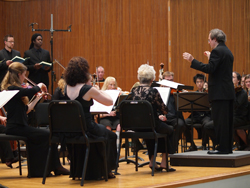by Daniel Hathaway

Though most of the repertory on Friday evening fell into the “not often played nor heard” category, Biber’s battle piece had the distinction of appearing on two area concert programs last week (it was also on the menu for ChamberFest Cleveland at Mixon Hall on Wednesday evening). This short and entertaining Baroque tone poem from 1673 depicts a motley and dissolute group of soldiers who get drunk and sing different songs at the same time, go into battle then lament their fallen fellows. An ensemble of three violins, four violas, two cellos, theorbo and harpsichord led by principal violinist Julie Andrijeski created cacophony worthy of Charles Ives and plausible battle sounds with dramatic snap pizzicatos.
Leopold’s Regina coeli, full of expressive Italianate gestures reminiscent of Monteverdi’s later music, featured mezzo-soprano Jennifer Lane. Her dark, focused voice brought special poignancy to the nuances of the text, accompanied by instrumental lines decorated by chromaticism and lemon-juice-in-the-eye cross relations. The continuo organ part was stylishly played by Webb Wiggins (a comic moment preceded the performance when the blower wasn’t plugged in and the tuning note took a moment to ooze up to its real pitch).
Known mainly as a theorist, Johann Joseph Fux also turns out to be an interesting composer. His Overture in d, a multi-movement work for a larger string ensemble enhanced by oboes and bassoon and conducted by Slowik, featured witty echoes and expressive silences and ended with an Aria that is really — like many concluding movements in this genre — a chaconne. Former Oberlin professor Lisa Goode Crawford rotated into the harpsichord position for the Fux, tastefully ornamenting her supporting role.
Well before the Eszterházy family finished building their estate in Hungary, a young Joseph Haydn signed on in their service and was charged with building a 14-piece orchestra for their winter palace in Vienna. One of the first compositional projects he undertook with the new band in 1761 was the triptych of “Morning”, “Noon” and “Night” symphonies, Nos. 6, 7 and 8. Slowick conducted an even larger string section plus flutes, oboes, bassoon and horns, in Le Midi to conclude the program.
Written not so long after the Baroque period “officially” ended in 1750 with the death of J.S. Bach, Le Midi has a fascinating structure alternating Recitativo with other musical forms and gives soloists a number of opportunities to show off their virtuosity in solos and duets. Violinist Marilyn McDonald and cellist Catharina Meints stepped into those roles with particularly splendid results. Flutists Kathie Stewart and Alison Melville, oboists Marc Schachman and David Dickey, and bassoonist Andrew Schwartz made distinguished contributions throughout. A pair of hornists borrowed from the early music program at Indiana University played valiantly and often brilliantly.
No less impressive playing opened the evening, when a student string orchestra energetically led by Michael Sponseller played Muffat’s 1682 Sonata I from Armonico Tributo. The strings purred like a stage full of contented cats in the opening Grave, and the ensemble made fine transitions between the Sonata’s other six movements. Slowik rightly lauded the group for the astonishing progress it had made during the course of the institute, which celebrated its 42nd year this summer.
Published on ClevelandClassical.com July 2, 2013
Click here for a printable version of this article.



